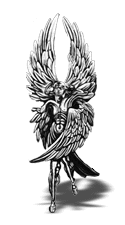Around 950 B.C., and after seven long years of construction, all Israel came to witness this day. Solomon's Temple, House of the Lord, awaited God and king atop the holy Mount of Moriah above the city of David. King Solomon had been dead for over 30 years. and the autumnal sun of the new year bathed the Temple's splendid limestone and burnished the bronze columns that framed its massive doors. So many animals were offered during the eight days of celebrations that they can not be told nor numbered for multitudes. The flames and smoke, wafting the savor of roasting meat, rose over the city from the altar. In the midst of the celebrations and accompanied by the sounds of trumpet, pipe and cymbals, the Ark was brought into the Temple. For the Lord hath chosen Zion; he hath desired it for his habitation (Psalms 132:13). Solomon led the procession of the elders and heads of Israel's tribes behind the Ark. The Temple's gold-inlaid doors swung open as the Ark was brought into the large vestibule and finally into its resting place inside the Holy of Holies. The Temple was a most spectacular and expensive construction project. If you could walk inside, all that you would see would be gold! The walls, the ceiling, even the floors were all covered with gold. Silver was nothing accounted of in the days of Solomon, He overlaid the (holy of holies) with pure gold...Solomon covered the inside of the Temple with pure gold...He overlaid the whole interior with gold...He also covered the floors of both the inner and outer rooms of the Temple with gold (1 Kings 6:20-30). Solomon fostered trade on land as well. The land of Israel has always been the hub of the Middle East. Through it passed caravans linking Mesopotamia, Syria and Egypt. When the queen of Sheba heard of the fame of Solomon...she came to Jerusalem (1 Kings 10:1). Romance and pageantry dramatized the queen of Sheba's summit with Solomon. Their meeting was immortalized by the Bible. The queen gave the king an hundred and twenty talents of gold, and of spices very great store, and precious stones (1 Kings 10:10). I believed not the words until I came said the queen, astounded by the splendor; and behold, the half was not told to me. The queen tested his wisdom to prove him with hard questions. The meetings must have gone well for Solomon gave unto the queen of Sheba all her desire, whatsoever she asked. As the king grew old, his hold on Israel weakened. Rebellions erupted on the border provinces. The Bible gives us the reasons for the king's downfall. He loved many strange women and he allowed them to continue their own forms of worship, defiling the Holy City with their foreign rituals and gods. And the aging Solomon not only tolerated this paganism but also indulged in it himself. Solomon had 700 wives and 300 concubines. Many of the exotic women were in fact living treaties. He maintained alliances by taking wives from the family of every potentate willing to sign a treaty. He even kept Egypt out of Israel by marrying an Egyptian princess, a daughter of a pharaoh. Nevertheless, the Lord promised, For as much as ...thou hast not kept my covenant... I will surely rend the kingdom (1 Kings 11:11). Soon after Solomon's death, in 922 B.C., Solomon's Temple was destroyed, his kingdom split in two. But his glory - and his realm - would live on forever, in the chronicles of his temple and the sagas immortalized by the Bible. The glory would endure in the memory of the king of whom it was written: there was none like thee before thee, neither after thee shall any arise like unto thee (1 Kings 3:12). Remaining Prayerful, Sis. Joyce Reaves |
| 970 BC -- 922 BC |
| Solomon, King of Israel, was the son and successor of King David. Building on Davidís achievements, Solomon instituted a proficient centralized government, with a professional army and an advanced trade network. Above all, he poured attention on Jerusalem, raising superb public buildings and palaces, and carrying out his fatherís plan to construct a Temple for the Lord, worthy to house the Ark of the Covenant. |
 |
 |
| King Solomon |
| The Bible tells us that Solomon called upon King Hiram of Tyre, who had been an alley of David, to help build the Temple. Israel had no experience in designing such lavish structures so Hiram supplied not only his cedar wood but also architects and artisans. As a result, Solomon's Temple essentially followed the plan of a Phoenician temple. The hiring of outsiders to build Israel's First Temple helps to explain the use of ornate doors, columns and religious symbolism foreign to the Hebrews' long practice of artistic ritual. Though the Israelites called their temple the House of the Lord, they only thought of it as the place where God's Name dwelt. Hiram's designers had a different approach. They conceived the Hebrews' God as a sovereign in his palace. They placed the Ark under the guard of winged sphinxes of Phoenician iconography: Cherubim, mythical creatures symbolizing omnipotence. The Cherubim combined in idea and shape the strength of the lion, the swiftness of the eagle, the procreative power of the bull and the wisdom of man. |

|
